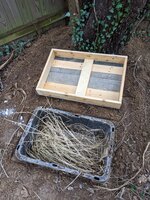Some axolotls hate red wigglers, some don't. I'd recommend buying a small batch from a bait shop or even Walmart to test whether or not they will be eaten before committing to a worm farm.
My own axolotl loves them and, like you, I wanted to start a worm farm. Mine has been doing quite well, so here's what I did from start to finish:
I bought two food safe buckets and one lid from Menards. They're probably about 4 gallons? They also happen to be kind of square-shaped, which has actually been a huge advantage. Someday I'd like to upgrade to something larger, but so far this has been suiting my needs just fine.
I drilled lots of pencil-thickness holes (about an inch and a half apart) in the bottom of one bucket and in the lid. I also drilled two larger (maybe 3/4 of an inch?) holes on each side of the bucket, one near the top and one near the bottom. These allow for drainage/ventilation.
The second bucket should not have any holes. It goes underneath (nesting style) the first to catch any water, dirt, or worms that get out of the first. I personally have used a brick put on it's side to make the gap between the buckets slightly bigger in order to allow for more aeration.
Of course, your worms can escape through the holes, so I used screen netting (again from Menards) to cover up the holes while still allowing them to fulfill their purpose. After some trial and error, I would recommend putting the netting outside the bucket walls rather than inside. Initially, I used a waterproof silicone sealant to kind of glue these in place, but it eventually came off the plastic. Honestly, duct tape worked a lot better and is easier to replace. I've had my worm farm for about a year and a half and have replaced to duct tape maybe two or three times?
Okay, now for the filling. I usually work in layers. The first thing I put in are some cut-to-fit cardboard egg cartons. The cardboard/the shape provide some stability at the bottom of the tank and also help with aeration. Since they do absorb a fair amount of moisture, I like to dip them in dechlorinated water first.
After that, I work in layers of dirt, dead leaves, dead grass, more cut up pieces of damp cardboard, and sometimes just a little bit of fine sand.
I know your question was mostly about which dirt to use, but honestly, it shouldn't be a big concern. Like you mentioned, you'll want something organic. I forget exactly what brand I typically use, but I know it has a fair amount of peat moss. I also like to buy an extra bag of just straight up peat moss because it seems to help. It's fairly absorbent though too, so I also have a spray bottle of dechlorinated water on hand to spritz onto the soil. Ultimately, your mix should always feel like a slightly damp sponge in terms of moisture.
On top, I like to add another loose layer of netting with some cedar chips on top. This really helps with the smell and the net makes it easy to remove them when you put in food.
I usually feed them every third day and when I do, I circulate the soil in the entire bin. This helps avoid any dead pockets of ammonia buildup, gives you a good idea of what's going on in there, and keeps everything healthy.
The bin should be kept in a cool, dark place. I try to clean out the bin/replace the bedding every 3-4 months.
I know that was a lot more info than you asked for, but I hope it helps!

